Geostrategic risks and digital infrastructure: a new priority for national resilience
- StratPlanTeam

- Dec 29, 2024
- 4 min read

Geostrategic Risks and Digital Infrastructure
Digital infrastructure now underpins almost every function of modern economies and governments, from communications and energy to finance, defence, and health systems. As global geopolitical tensions rise, so too do the risks to this infrastructure. Submarine cables, satellites, data centres, and cloud computing systems are increasingly becoming targets or casualties in the broader contest for strategic advantage.
This article explores how geostrategic risk is reshaping the landscape of digital infrastructure planning and governance, with a focus on submarine cables, cloud systems, and data sovereignty. It highlights why governments must treat these systems as critical national infrastructure—and how to build resilience in a more uncertain world.
The growing strategic importance of digital infrastructure
Digital infrastructure, once largely the domain of engineers and IT managers, is now central to defence, diplomacy, and national security planning. Cloud storage, satellite communications, submarine fibre optic cables, and hyperscale data centres form the backbone of the modern economy. Their disruption—whether by natural disasters, cyber attacks, or geopolitical conflict—can severely affect a nation’s ability to function.
Several trends have brought this shift into sharper focus:
The weaponisation of interdependence: Nations are increasingly using their control over digital chokepoints—such as cloud platforms, undersea cables, or microchip supply chains—as tools of influence or coercion.
A rise in hybrid conflict: Infrastructure that was once seen as neutral or purely commercial is now being targeted as part of wider strategic competition.
Digital infrastructure as a theatre of escalation: From Ukraine to the Pacific, attacks on or threats to digital systems are becoming more common in geopolitical flashpoints.
Submarine cables: a fragile foundation for global connectivity
In 2025, submarine cable failures continue to present as a significant national vulnerability, particularly given the reliance on these cables for global communication and internet traffic. These failures, whether accidental or deliberate, can have serious consequences for economies, governments, and military operations. Over 95% of intercontinental internet traffic and $10 trillion in financial transactions daily rely on these cables.
Key vulnerabilities and concerns:
Accidental damage: Ship anchors and natural events such as seismic activity remain major causes of cable failure, as evidenced by recent incidents in the Baltic Sea and Red Sea.
Potential for sabotage: Geopolitical tensions, particularly near Taiwan and the Baltic, are fuelling concerns about deliberate attacks, with some incidents involving vessels linked to Russia or China.
Limited repair capacity: Fixing broken cables requires specialised vessels and can take days or weeks—exposing countries to prolonged outages.
Lack of awareness: Maritime agencies and commercial operators may not fully understand cable locations or the criticality of avoiding them.
Cybersecurity risks: Beyond physical damage, attacks on the data flowing through cables also pose major threats.
Addressing vulnerabilities:
International cooperation: Governments are increasing information-sharing, surveillance coordination, and standard-setting to jointly protect undersea infrastructure.
Faster repair capabilities: New technologies and greater investment are being directed at improving the speed and availability of repair services.
Enhanced surveillance and security: AI and satellite monitoring are being deployed to detect unusual vessel patterns and provide early warnings.
Public-private partnerships: Cable operators and tech companies are working more closely with defence and security agencies to build resilience.
Diplomatic engagement: Nations are using 'cable diplomacy' to build norms and cooperation to reduce the risk of escalation.
Case examples:
Taiwan: The Taiwanese Ministry of National Defense is stepping up monitoring of submarine cable zones to detect and deter potential sabotage.
Baltic Sea: NATO has increased surveillance, using AI to track vessels and developing plans for rapid incident response.
Global: Several countries are now focused on developing a stronger international framework to support cable security.
Cloud sovereignty and hyperscale exposure
As governments increasingly rely on public cloud infrastructure, questions of control and sovereignty come to the fore. Cloud platforms are typically operated by a small number of global providers, many of whom are based in the US or China. This raises concerns about jurisdiction, data access, and vulnerability to foreign government intervention.
The growing prevalence of hyperscale data centres also creates physical vulnerabilities. These centres are large, energy-hungry, and often concentrated in clusters—making them attractive targets for cyber attacks or sabotage. Moreover, the geopolitical affiliations of cloud providers have become a factor in procurement decisions and national infrastructure planning.
Data localisation and regional resilience
In response to geopolitical pressures, many governments are pursuing data localisation policies—requiring certain categories of data to be stored and processed within national borders. While this can improve control and reduce exposure, it also risks fragmenting the global internet and increasing costs.
At the same time, efforts are underway to create more regionally distributed data infrastructure, including edge computing nodes and satellite-based storage. These approaches can enhance resilience by reducing dependence on a small number of centralised systems.
A call to reframe digital infrastructure as strategic infrastructure
In this new landscape, governments can no longer treat digital infrastructure as merely a technical or commercial issue. It must be governed, protected, and invested in as critical national infrastructure. This requires:
Whole-of-government planning across defence, foreign affairs, digital policy, and economic development.
Greater coordination with the private sector, especially hyperscale cloud and telecom providers.
Investment in redundancy, surveillance, and rapid response capabilities.
Stronger international norms and alliances to protect shared infrastructure.
Above all, it requires a mindset shift - beyond the traditional definitions of infrastructure and to a whole of nation approach to risk management.






Comments